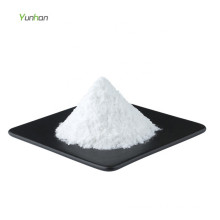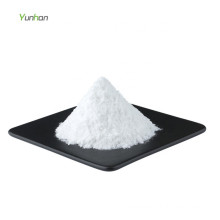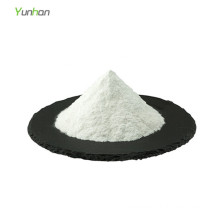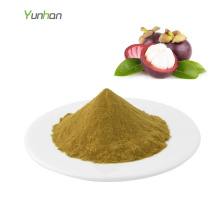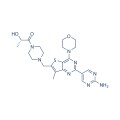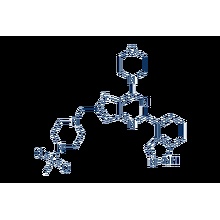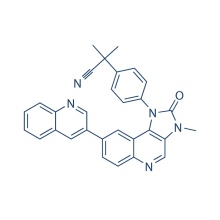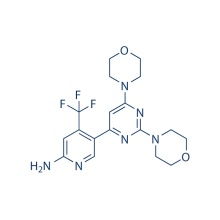Apitolisib (GDC-0980, RG7422) 1032754-93-0
Product Description
.cp_wz table {border-top: 1px solid #ccc;border-left:1px solid #ccc; } .cp_wz table td{border-right: 1px solid #ccc; border-bottom: 1px solid #ccc; padding: 5px 0px 0px 5px;} .cp_wz table th {border-right: 1px solid #ccc;border-bottom: 1px solid #ccc; padding: 5px 0px 0px 5px;}
Molecular Weight: 498.6 Apitolisib (GDC-0980, RG7422) is a potent, class I PI3K Inhibitor for PI3Kα/β/δ/γ with IC50 of 5 nM/27 nM/7 nM/14 nM, respectively. Also a mTOR Inhibitor with Ki of 17 nM, and highly selective versus other PIKK family kinases. Phase 2.
GDC-0980 shows the potent and selective inhibitory activities against
class I PI3K and mTOR kinase versus a large panel of kinases with Ki of 17 nM for mTOR and IC50 of 5 nM, 27 nM, 7 nM, and 14 nM for PI3Kα, β, δ, and γ, respectively. In vitro, GDC-0980 significantly inhibits cell proliferation in PC3 and
MCF7 cells with IC50 of 307 nM and 255 nM, respectively. A recent study shows that GDC-0980 reduces cancer cell viability by
inhibiting cell-cycle procession and inducing Apoptosis with most
potency in prostate (IC50
In both PC-3 and MCF-7 neo/HER2 xenograft models, GDC-0980 at a dose of 1
mg/kg, exhibits significant antitumor activity by causing tumor growth
delay. Furthermore, GDC-0980 results in tumor stasis or regressions at
the maximum tolerated dose of 7.5 mg/kg. [1] In mice, intravenous GDC-0980 administration at 1 mg/kg leads to low clearance (Clp: 9.2 mL/min/kg, Vss:
1.7 L/kg). While, oral administration at 5 mg/kg in 80% PEG400 and at
50 mg/kg as a crystalline suspension in 0.5% methylcellulose/0.2%
Tween-80 also results in favorable pharmacokinetic parameters.
A potent, selective, and orally available inhibitor of PI3Kα, β, δ, γ and mTOR.
Protocol(Only for Reference)
Kinase Assay: [1]
Cell Assay: [1]
Animal Study: [1]
Conversion of different model animals based on BSA (Value based on data from FDA Draft Guidelines)
For example, to modify the dose of resveratrol used for a mouse (22.4 mg/kg) to a dose based on the BSA for a rat, multiply 22.4 mg/kg by the Km factor for a mouse and then divide by the Km factor for a rat. This calculation results in a rat equivalent dose for resveratrol of 11.2 mg/kg.
Chemical Information
Molarity Calculator
Dilution Calculator
Molecular Weight Calculator
Contact us if you need more details on Apitolisib 1032754-93-0. We are ready to answer your questions on packaging, logistics, certification or any Other aspects about GDC-0980 1032754-93-0、RG7422 1032754-93-0. If these products fail to match your need, please contact us and we would like to provide relevant information.
Molecular Weight: 498.6 Apitolisib (GDC-0980, RG7422) is a potent, class I PI3K Inhibitor for PI3Kα/β/δ/γ with IC50 of 5 nM/27 nM/7 nM/14 nM, respectively. Also a mTOR Inhibitor with Ki of 17 nM, and highly selective versus other PIKK family kinases. Phase 2.
GDC-0980 shows the potent and selective inhibitory activities against
class I PI3K and mTOR kinase versus a large panel of kinases with Ki of 17 nM for mTOR and IC50 of 5 nM, 27 nM, 7 nM, and 14 nM for PI3Kα, β, δ, and γ, respectively. In vitro, GDC-0980 significantly inhibits cell proliferation in PC3 and
MCF7 cells with IC50 of 307 nM and 255 nM, respectively. A recent study shows that GDC-0980 reduces cancer cell viability by
inhibiting cell-cycle procession and inducing Apoptosis with most
potency in prostate (IC50
In both PC-3 and MCF-7 neo/HER2 xenograft models, GDC-0980 at a dose of 1
mg/kg, exhibits significant antitumor activity by causing tumor growth
delay. Furthermore, GDC-0980 results in tumor stasis or regressions at
the maximum tolerated dose of 7.5 mg/kg. [1] In mice, intravenous GDC-0980 administration at 1 mg/kg leads to low clearance (Clp: 9.2 mL/min/kg, Vss:
1.7 L/kg). While, oral administration at 5 mg/kg in 80% PEG400 and at
50 mg/kg as a crystalline suspension in 0.5% methylcellulose/0.2%
Tween-80 also results in favorable pharmacokinetic parameters.
A potent, selective, and orally available inhibitor of PI3Kα, β, δ, γ and mTOR.
Protocol(Only for Reference)
Kinase Assay: [1]
| Enzymatic activity | Enzymatic activity of the Class I PI3K isoforms is measured using a fluorescence polarization assay that monitors formation of the product 3,4,5-inositoltriphosphate molecule as it competes with fluorescently labeled PIP3 for binding to the GRP-1 pleckstrin homology domain protein. An increase in phosphatidyl inositide-3-phosphate product results in a decrease in fluorescence polarization signal as the labeled fluorophore is displaced from the GRP-1 protein binding site. Class I PI3K isoforms are expressed and purified as heterodimeric recombinant Proteins. PI3K isoforms are assayed under initial rate conditions in the presence of 10 mM Tris (pH 7.5), 25 μM ATP, 9.75 μM PIP2, 5% glycerol, 4 mM MgCl2, 50 mM NaCl, 0.05% (v/v) Chaps, 1 mM dithiothreitol, 2% (v/v) DMSO at the following concentrations for each isoform: PI3Kα,β at 60 ng/mL; PI3Kγ at 8 ng/mL; PI3Kδ at 45 ng/mL. After assay for 30 minutes at 25°C, reactions are terminated with a final concentration of 9 mM EDTA, 4.5 nM TAMRA-PIP3, and 4.2 μg/mL GRP-1 detector protein before reading fluorescence polarization on an Envision plate reader. IC50s are calculated from the fit of the dose−response curves to a 4-parameter equation.Human recombinant mTOR(1360−2549) is expressed and purified from insect cells and assayed using a Lanthascreen fluorescence resonance energy transfer format in which phosphorylation of recombinant green fluorescent protein (GFP)-4-EBP1 is detected using a terbium-labeled antibody to phospho-threonine 37/46 of 4-EBP1. Reactions are initiated with ATP and conducted in the presence of 50 mM Hepes (pH 7.5), 0.25 nM mTOR, 400 nM GFP-4E-BP1, 8 μM ATP, 0.01% (v/v) Tween 20, 10 mM MnCl2, 1 mM EGTA, 1 mM dithiothreitol, and 1% (v/v) DMSO. Assays are conducted under initial rate conditions at room temperature for 30 minutes before terminating the reaction and detecting product in the presence of 2 nM Tb-anti-p4E-BP1 antibody and 10 mM EDTA. Dose−response curves are fit to an equation for competitive tight-binding inhibition and apparent Ki' s are calculated using the determined Km for ATP of 6.1 μM. |
|---|
Cell Assay: [1]
| Cell lines | PC3 and MCF7.1 |
|---|---|
| Concentrations | 0 to 10 μM |
| Incubation Time | 72 hours or 96 hours |
| Method | Antiproliferative cellular assays are conducted using PC3 and MCF7.1 human tumor cell lines. MCF7.1 is an in vivo selected line and originally derived from the parental human MCF7 breast cancer cell line. Cell lines are cultured in RPMI supplemented with 10% fetal bovine serum, 100 units/mL penicillin, and 100 μg/mL streptomycin, 10 mM HEPES, and 2 mM glutamine at 3°C under 5% CO2. MCF7.1 cells or PC3 cells are seeded in 384-well plates in media at 1000 cells/well or 3000 cells/well, respectively, and incubated overnight prior to the addition of GDC-0980 to a final DMSO concentration of 0.5% v/v. MCF7.1 cells and PC3 cells are incubated for 3 days and 4 days, respectively, prior to the addition of CellTiter-Glo reagen and reading of luminescence using an Analyst plate reader. For antiproliferative assays, a cytostatic agent such as aphidicolin and a cytotoxic agent such as staurosporine are included as controls. Dose−response curves are fit to a 4-parameter equation and relative IC50s are calculated using Assay Explorer software. |
Animal Study: [1]
| Animal Models | PC3 and MCF7.1 cells are injected s.c. into the right hind flank of athymic nu/nu (nude) mice. | ||
|---|---|---|---|
| Formulation | GDC-0980 is dissolved in 0.5% methylcellulose with 0.2% Tween-80 (MCT). | ||
| Dosages | ≤7.5 mg/kg | ||
| Administration | Administered via p.o. | ||
| Solubility | 0.5% methylcellulose/0.2% Tween 80, 30 mg/mL | ||
| * Please note that Selleck tests the solubility of all compounds in-house, and the actual solubility may differ slightly from published values. This is normal and is due to slight batch-to-batch variations. | |||
Conversion of different model animals based on BSA (Value based on data from FDA Draft Guidelines)
| Species | Baboon | Dog | Monkey | Rabbit | Guinea pig | Rat | Hamster | Mouse |
| Weight (kg) | 12 | 10 | 3 | 1.8 | 0.4 | 0.15 | 0.08 | 0.02 |
| Body Surface Area (m2) | 0.6 | 0.5 | 0.24 | 0.15 | 0.05 | 0.025 | 0.02 | 0.007 |
| Km factor | 20 | 20 | 12 | 12 | 8 | 6 | 5 | 3 |
| Animal A (mg/kg) = Animal B (mg/kg) multiplied by | Animal B Km |
| Animal A Km |
For example, to modify the dose of resveratrol used for a mouse (22.4 mg/kg) to a dose based on the BSA for a rat, multiply 22.4 mg/kg by the Km factor for a mouse and then divide by the Km factor for a rat. This calculation results in a rat equivalent dose for resveratrol of 11.2 mg/kg.
| Rat dose (mg/kg) = mouse dose (22.4 mg/kg) × | mouse Km(3) | = 11.2 mg/kg |
| rat Km(6) |
Chemical Information
| Molecular Weight (MW) | 498.6 |
|---|---|
| Formula | C23H30N8O3S |
| CAS No. | 1032754-93-0 |
| Storage | 3 years -20℃Powder |
|---|---|
| 6 months-80℃in solvent (DMSO, water, etc.) | |
| Synonyms | |
| Solubility (25°C) * | In vitro | DMSO | 20 mg/mL (40.11 mM) |
|---|---|---|---|
| Water | <1 mg/mL ( | ||
| Ethanol | <1 mg/mL ( | ||
| In vivo | 0.5% methylcellulose/0.2% Tween 80 | 30 mg/mL | |
| * <1 mg/ml means slightly soluble or insoluble. * Please note that Selleck tests the solubility of all compounds in-house, and the actual solubility may differ slightly from published values. This is normal and is due to slight batch-to-batch variations. | |||
| Chemical Name | (S)-1-(4-((2-(2-aminopyrimidin-5-yl)-7-methyl-4-morpholinothieno[3,2-d]pyrimidin-6-yl)methyl)piperazin-1-yl)-2-hydroxypropan-1-one |
|---|
Molarity Calculator
Dilution Calculator
Molecular Weight Calculator
Contact us if you need more details on Apitolisib 1032754-93-0. We are ready to answer your questions on packaging, logistics, certification or any Other aspects about GDC-0980 1032754-93-0、RG7422 1032754-93-0. If these products fail to match your need, please contact us and we would like to provide relevant information.
Product Categories : PI3K/Akt/mTOR > PI3K Inhibitor
Other Products
Hot Products
Astragaloside AChlortetracycline HCl 64-72-2Paclitaxel 33069-62-4Dexamethasone Acetate 1177-87-3Dinaciclib (SCH727965) 779353-01-4CHIR-124 405168-58-3Ro3280 1062243-51-9TAME 901-47-3CCG-1423 285986-88-110058-F4 403811-55-2Dabigatran (BIBR 953) 211914-51-1H 89 2HCl 130964-39-5T0901317 293754-55-9Aprepitant 170729-80-3Turofexorate Isopropyl (XL335) 629664-81-9BMS-378806 357263-13-9


